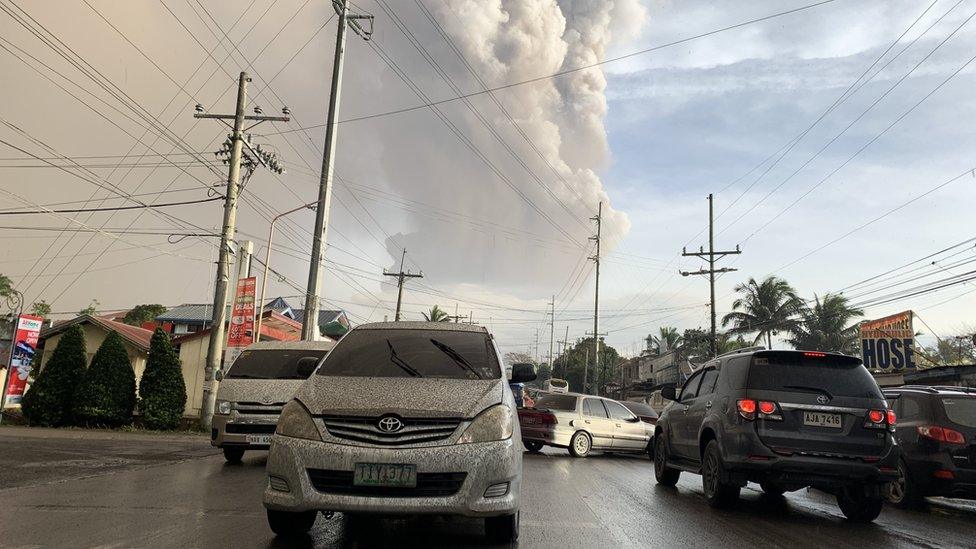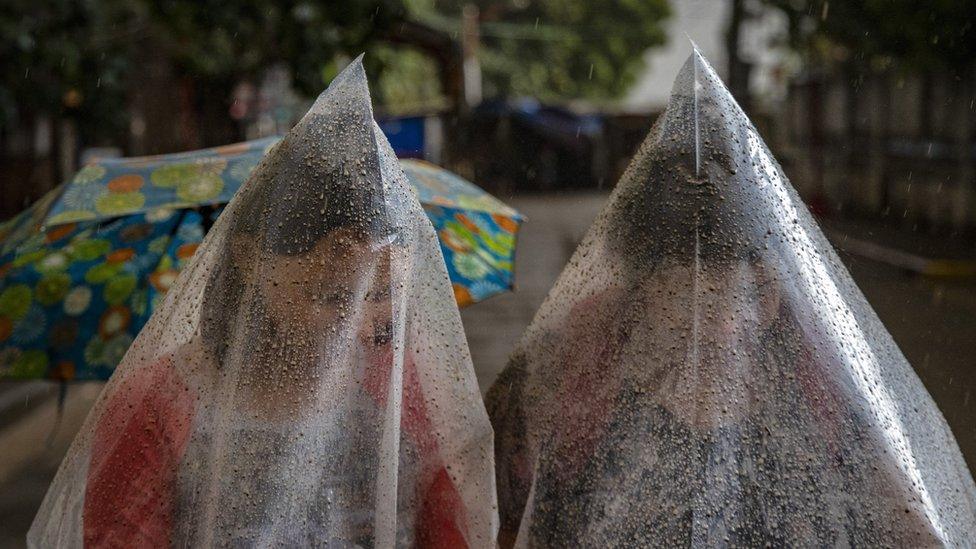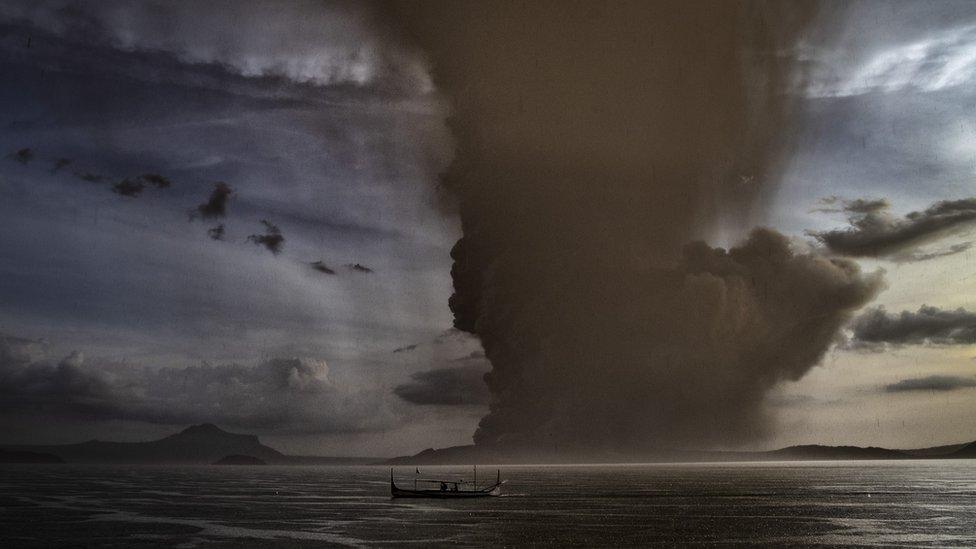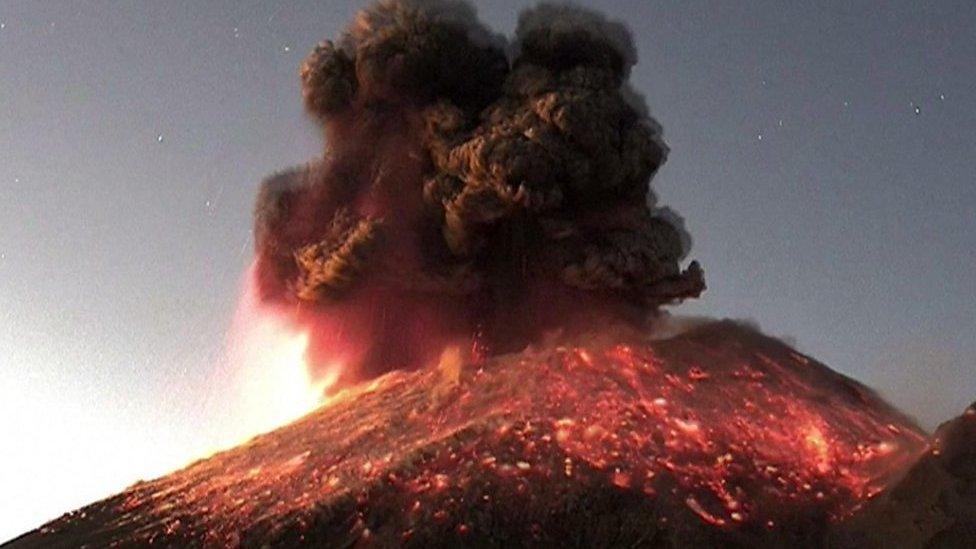Taal volcano: Your questions answered
- Published
Time-lapse of lightning storm swirling round Philippine volcano
Lava has started to emerge from the Taal volcano in the Philippines, as the nation prepares for a "hazardous eruption".
Local authorities have also declared a "state of calamity".
Meanwhile, the volcano has cast a lightning storm into the air, and the surrounding area has been blanketed with ash.
But how dangerous is the ash, why is there lightning in the clouds thrown up by Taal, and could this have an impact on the bushfires in Australia?
Dave Rothery, professor of planetary geosciences at the Open University, answers readers' questions.

What causes the lightning in the ash cloud? - Tim Donaldson
Lightning is a common phenomenon in volcanic eruption clouds, but we have certainly become more familiar with it thanks to the number of cameras capturing eruption pictures these days.
In an explosive eruption, rock is fragmented into tiny pieces, referred to as "ash" - though not a product of combustion like the ash from a fire. Those particles can carry electrical charges, while frictional collisions between grains can also build up charge.
If the positively-charged ash particles become separated from the negatively-charged particles in sufficient quantity, and the two oppositely charged regions become temporarily linked, this is a lightning bolt. A similar process occurs in thunderclouds.
It is thought in volcanic lightning the charges could be carried by ions - charged individual atoms - rather than specks of ash.

Ash has started falling on areas around the volcano
Is the ash a hazard to one's health? - Robert Aguiniga
Volcanic ash poses a number of health hazards.
It is a nasal and respiratory irritant, and so people need to avoid inhaling it - which means if you are below an ash fall, stay indoors or wear a mask. Going outdoors after ashfall, avoid kicking it up which would reactivate the original hazard. You wouldn't want it in your eyes either, as the particles are sharp.
Ash can carry poisons such as fluorine, and sheep in Iceland have died from eating grass tainted by ash from local eruptions, but this does not affect people directly.
Other problems that ashfall can cause include: stripping leaves from vegetation, building up on roofs until they collapse, and turning into devastating mudflows, called lahars, when the first heavy rainfall occurs.
So far in the current Taal eruption, the eruption column has not exceeded more than about 1km (3,281ft) high, so the ash has not travelled very far.

Some residents wore plastic bags to protect themselves from volcanic ash mixed with rainwater
Will the ash and gas from Taal reach the stratosphere? - Mike Rhode
To reach the stratosphere, an eruption column from Taal volcano would need to reach about 15km or more in height, which is the approximate base of the stratosphere at Taal's latitude, only 14 degrees north of the equator.
This may have happened in its 1754 and 1965 eruptions, so it could happen again.
What are the chances of full eruption? - Daniel Reaney
I guess by "full eruption" you mean something like the 1991 eruption of Pinatubo, which lies about as far to the north-west of Manila as Taal is to the south. That measured six on the Volcano Explosivity Index (VEI) scale when the eruption column reached a height of 24km.
The last time Taal had an eruption on that sort of scale was about 5,500 years ago, whereas it had VEI-4 eruptions in 1716, 1749, 1754 and 1965.
So far, Taal's current eruption is much smaller. The authorities have wisely declared a 15km radius evacuation zone, and Manila airport has been closed at times for fear of airborne ash affecting jet engines.
Taal could ramp up to something really big, but it is more likely to continue as it is for a while before quietening down again.
Can eruption of one volcano lead to the eruption of others in this or nearby countries? - Harish Kumar
There is no known mechanism for an eruption at one volcano to set off an eruption at another volcano. Their magma plumbing systems are not directly connected, despite adjacent volcanoes being fed from the same source. The same really powerful earthquake might trigger two very close volcanoes, but that is about it.
Taal volcano, like the other volcanoes in the Philippines, Japan and Indonesia, are a consequence of plate tectonics. An oceanic plate is being pushed (subducted) below an island arc. Melting begins at a depth of about 70km, and the magma, which is the molten rock below the earth's crust, rises up to feed volcanoes.
This is a slow process, with magma taking thousands of years (or longer) to migrate to the surface. A particular volcano will not erupt until there is enough magma and associated gas collected in its shallow magma chamber. Sometimes an earthquake can prematurely set off an eruption that might not have happened for a few more years.
Will the eruption, if this volcano erupts, affect the fires in Australia? - Katherine Gonzalez
If Taal was to have a really big eruption producing a large ash cloud, I do not think it would have any impact on the fires in Australia. An ash cloud from Taal would be unlikely to spread far into the southern hemisphere, even if high-altitude winds were to spread it right round the globe.
That is a shame in this case, because fine ash in the air can lead to extra rainfall, which presumably would be welcome in south-eastern Australia because of the bushfires.
- Published13 January 2020

- Published12 January 2020

- Published12 December 2019

- Published10 January 2020
